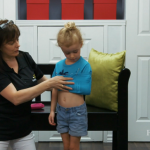

- 11 May 2020
- |
- Andrée Bouchard
With the arrival of the warm weather, outdoor playtime and visits to the nearby playground multiply. The melting snow may have left behind a variety of objects, including used syringes, which can sometimes be found in parks, playgrounds, schoolyards, in garbage cans, on sidewalks or simply in the street. It’s important to know that a syringe found in the wild can represent a danger.
Some viral diseases can be transmitted by a puncture with the hollow needle of a syringe or any other material containing blood belonging to a virus-carrying person. Blood is a means of transmitting certain viruses. In the event of accidental pricking on a used syringe, the risk of transmission of the HIV/AIDS virus is low, but not non-existent. On the other hand, the risk of transmission of the hepatitis B and C viruses is greater. The main victims of accidental needlestick injuries are children and certain workers.
Even if the risk of viral contamination is low, accidentally pricking yourself on a syringe can cause injury and anxiety. Such incidents should be taken seriously.
What to do in the event of an accidental bite?
Wash hands thoroughly with soap and water, and apply a bandage. Seek prompt medical attention in an emergency room, if possible within two hours. At the reception desk, mention that you’ve been pricked with a used syringe.
What to do if you find a used syringe?
The first thing to do is to prevent others from touching it. If you have to pick it up yourself, take it carefully and put it in a container. Contact the Info-Santé telephone service at 811 to find out how to dispose of the syringe.
Never dispose of used syringes in the trash or in a recycling bin, but take them to a pharmacy or CLSC instead.
The Ministère de la Santé et des Services Sociaux provides a downloadable fact sheet: http://publications.msss.gouv.qc.ca/msss/fichiers/2014/14-316-01WF.pdf




